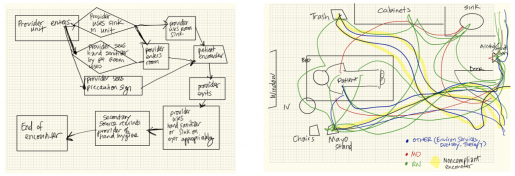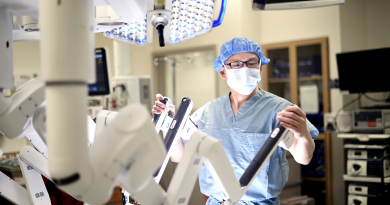Washed out: Addressing hand hygiene in healthcare
As a medical student, institutional signage competes for your attention every day: flyers about upcoming fire drills, seating assignments for an exam, or lunch specials in the cafeteria. Announcements seem to be posted everywhere.
As you go about your day, you are in and out of patient rooms, usually in less than 20 seconds, and usually without acting on one of the most important messages: Wash Your Hands Before Your Leave the Room. In fact, you’ve probably walked past a dozen hand hygiene reminder posters, but you didn’t notice them because you had so many details on your mind.
Maybe you didn’t notice the handwashing reminder signs because they were simply dull and blended in with the neutral walls. Or perhaps you saw them, but your brain filtered them out so quickly that the message never reached your conscious awareness.
You may have even registered the thought but decided to forgo sticky sanitizer hands since this was such a short, contact-free patient interaction. No harm done, right?
Wrong.
National estimates reveal that at least 50% of healthcare workers do not properly comply with designated hand hygiene techniques, while clean hands are the single most important factor in antibiotic resistance and preventing the spread of pathogens.
In the United States alone, nearly two million patients contract a hospital-acquired infection, and about 90,000 of those patients die as a result.
Pretty sobering data.
Enter the Toyota LEAN model. In the 1930s, leadership at Toyota began to focus on small, targeted changes that improved the flow of the entire production process. The LEAN model emphasizes alterations to the overall system rather than micromanaging individual units.

Process flow maps demonstrate the early stages of the LEAN strategy, in which a multidisciplinary team meet in person several times to map out the real-life patient encounter and identify areas for improvement.
You may be wondering how this is relevant to hand hygiene compliance in healthcare. But in the depths of the Michael E. DeBakey VA Medical Center (MEDVAMC) surgical administration suite, Baylor College of Medicine physicians decided to put the methodology to a test. They assembled a team of physicians, nurses, and administrators who were convened specifically to apply LEAN methodologies to hand hygiene.
Dr. Samir Awad, professor and vice-chair of surgical quality and safety at Baylor, and chief of surgery at MEDVAMC, and the dedicated team drilled down on the underlying causes of the issue and created a series of charts, diagrams, and analyses.
Their study revealed multiple reasons for low compliance: distraction, not directly touching the patient (and therefore not feeling the need to wash), and neglect in compliance education among non-patient care workers.
A final root cause analysis revealed poor situational awareness as the underlying thread weaving together all of the factors in poor compliance.
Following this in-depth LEAN Model analysis, six months of targeted coaching addressed the identified deficiencies and created a 12% increase in handwashing in the ward, which is quite an improvement in a short amount of time.
The conclusion? Viewing hand hygiene through the lens of a production model might be something that more institutions want to explore for themselves.
-By Bianca Rombado, third-year medical student at Baylor College of Medicine




